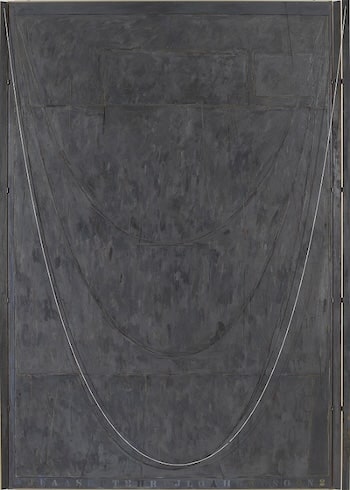Near the Lagoon, 2002-03 by Jasper Johns

Jasper Johns has often affixed objects to the surfaces of his paintings in an ongoing search for non-illusionistic ways of mediating between the flat plane of the picture and a fully dimensional world. For his Catenary series
(1997-2003), of which Near the Lagoon is the largest and last work, Johns formed catenaries - a term used to describe the curve assumed by a cord suspended freely from two points - by tacking ordinary household string to
the canvas or its supports. In Near the Lagoon, the string activates and engages the abstract, collaged field of multitonal gray behind it, casting an actual shadow on the canvas, in addition to the painted ones that Johns
rendered by hand; the string even creates a rut where the artist embedded it into and later pulled it out of the encaustic.
Near the Lagoon was purchased and put on display as former The Art Institute of Chicago director James N. Wood was preparing to retire. "One of the things I found so moving about
Near the Lagoon" Wood says, "is that it's a masterpiece by a totally mature artist creating profound work at an advanced age. He's looking back on himself and on the history of art. There are a number of extraordinary
artists who did this - Titian, Rembrandt, Vermeer. We're obsessed in this country with the notion that an artist's earlier art is always
the most important." Wood adds that the collaged canvas pieces are Johns's reference to a painting Manet did but disliked and cut up, later pieced together by
Edgar Degas. "There are so few works of art that simultaneously embody looking, making, and thinking about painting. It's in the tradition of Diego Velazquez,
Edouard Manet, Paul Cezanne, Jackson Pollock, and the plan is to keep it on view almost all the time."
